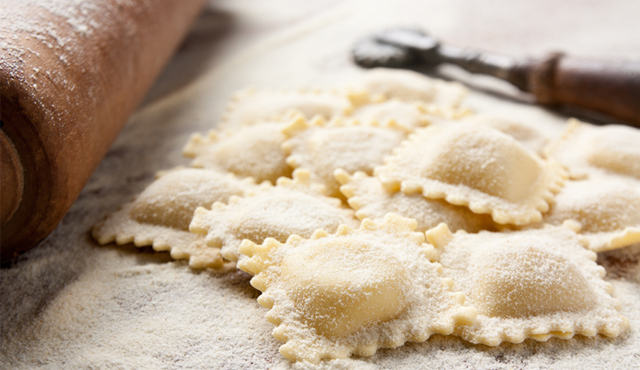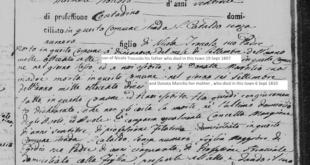I’m a little girl waking up. It’s Thanksgiving and there it is — the metallic tap, tap of my mother’s spoon against the rim of the large stainless steel pot. Della Serritella Rocco has been alone at work long before first light. Inside the pot are pork neckbones, inexpensive but delicious, together with fresh tomatoes and herbs, creating the luscious gravy — no one called it sauce back then — that would dress the divine homemade ravioli momma is about to create in her humble kitchen. This is a labor-intensive effort, reserved for holiday feasts like Thanksgiving, Christmas and Easter.
Remembering this today when I am now the grandmother who plans to bring ravioli to our family’s Thanksgiving dinner next week fills me with awe of my mother and her cohort. Bear in mind no one requested I bring food. I was never hailed as a prodigious cook the only comments from our three sons have centered on my hockey puck port chops. (Those aren’t my fault: My 4th grade teacher, Marie C. Butler, warned us of trichinosis from eating undercooked pork. I believed her.)
Italian mothers were famous for their culinary diligence. Homemade bread and pasta were routine. In my mother’s final illness, as she left for the hospital, fresh loaves of bread were left on the kitchen table. I kept one in my freezer for years. I did gift each of my sons a properly wrapped piece for a keepsake. In any case, no machines were involved.
Ravioli began life as a mountain of flour in the ancient stoneware bowl my mother inherited from her mother: her entire legacy. My mother born in Italy in 1903, was highly intelligent and articulate in English, but was rather reticent. Sadly, neither my elder sister, Christine, nor I were ever instructed in the mystery of concocting the holiday ravioli. I never wondered why. Perhaps my mother’s generation had worked so very hard they sought to spare their children from similar experiences. Life in southern Italy at the turn of the last century was brutal for ordinary folk. America truly was the shining city on the hill to them. That they were brave enough to make the long journey to another land speaks to their inbred talents, which America allowed to blossom.
My mother’s tools were simple — a slab of wood saved probably from an old door and a long broom handle clinically cleaned and sanded. After the proper ingredients were added to the flour — I’d tell you if I knew what they were — the mixture was given a brief rest. Finally, the dough was ready.
I can see my mother diligently working at the heaping mass of rendered flour when it was ready. The correct kneading was important. Then mother’s broom handle rolling pin began its magic. Using considerable arm strength, she smoothed the dough until it was shimmeringly supple. The result was a sheet of satin resting atop a slab of wood awaiting the dollops of fresh ricotta cheese mixture placed in a precise row. The edge of the huge satiny sheet of dough was then flipped over the row of cheese balls with the rolling pin — How she managed it I could never grasp, She then cut to separate the row from the sheet of dough. The final act was to cut each little individual ravioli square. Her final flourish was a deft touch to dimple the mound of cheese. Imagine this action repeated to make 100 to 200 individual “ravs.”
This is where I would be called in to do my job. As the family’s youngest, it was my duty to seal each individual rav by using an ordinary kitchen dinner fork to press all edges of each ravioli. Afterward, I would place the finished ravs on the clean tablecloth on the bed in nearby bedroom.
Some time when I was 10 ten something miraculous happened to raviolis. The neighborhood Italian deli/grocery, I believe the name was D’Andrea’s, began making and selling frozen “homemade” versions. It is impossible to overstate the excitement this invention created. Of course, my mother didn’t abandon her ravioli making, but the truth is, this was the beginning of the end.
Eventually, frozen food sections in major grocery stores began to sell frozen ravioli, much like the Celeste pizzas that became available. Celeste (the person) cooked pizzas and pastas in the family restaurant in the neighborhood where my future husband and his parents dined on Wednesday: the day his barber father was off work.
While we have fond memories of delicious holiday ravioli dinners, it is clear it was no holiday for my mother. Never did she complain or indicate she wanted to quit. On the other hand, my father, born in 1900, often seemed to have a holiday headache and didn’t so much as lift a dish. Most men of that generation were not highly involved in domestic duties.
Today, my sons and their wives are marvelous cooks, as my husband once was. For myself, I retired long ago and tell people I only have a kitchen because it came with the house.
So, for Thanksgiving, we will be preparing a casserole made of store-bought frozen ravioli dressed with prepared “sauce” acquired from a local Italian restaurant. I hope my mother never learns of this from the comfort of heaven. Progress is a two-edged sword. It often makes life easier, but it is doubtful any one will have fond memories of our ravioli in 50 years.
What they will remember, I hope, is the importance of everyone getting together for the holiday. For those who can’t, progress will bring them to the table via Facetime.
I find it somewhat sad that I have never been able to create culinary delights for my family. I lack the ability to taste a dish and mimic the ingredients. Most of all, the notion of “raw” food stuffs is unappealing. I thank my lucky stars I missed the earlier times when mothers bought live chickens and had to kill, pluck and prepare them.
I do harbor a deep sense of respect for the great gift my mother and others of her generation gave to their families with the beautifully prepared labor-intensive holiday dinners. They fed our souls as well as our appetites and for that we revere them, and cherish the memories.
Rest in peace beloved ravioli-makers.
(Angela Rocco DeCarlo, copyright 2022)
 Fra Noi Embrace Your Inner Italian
Fra Noi Embrace Your Inner Italian







